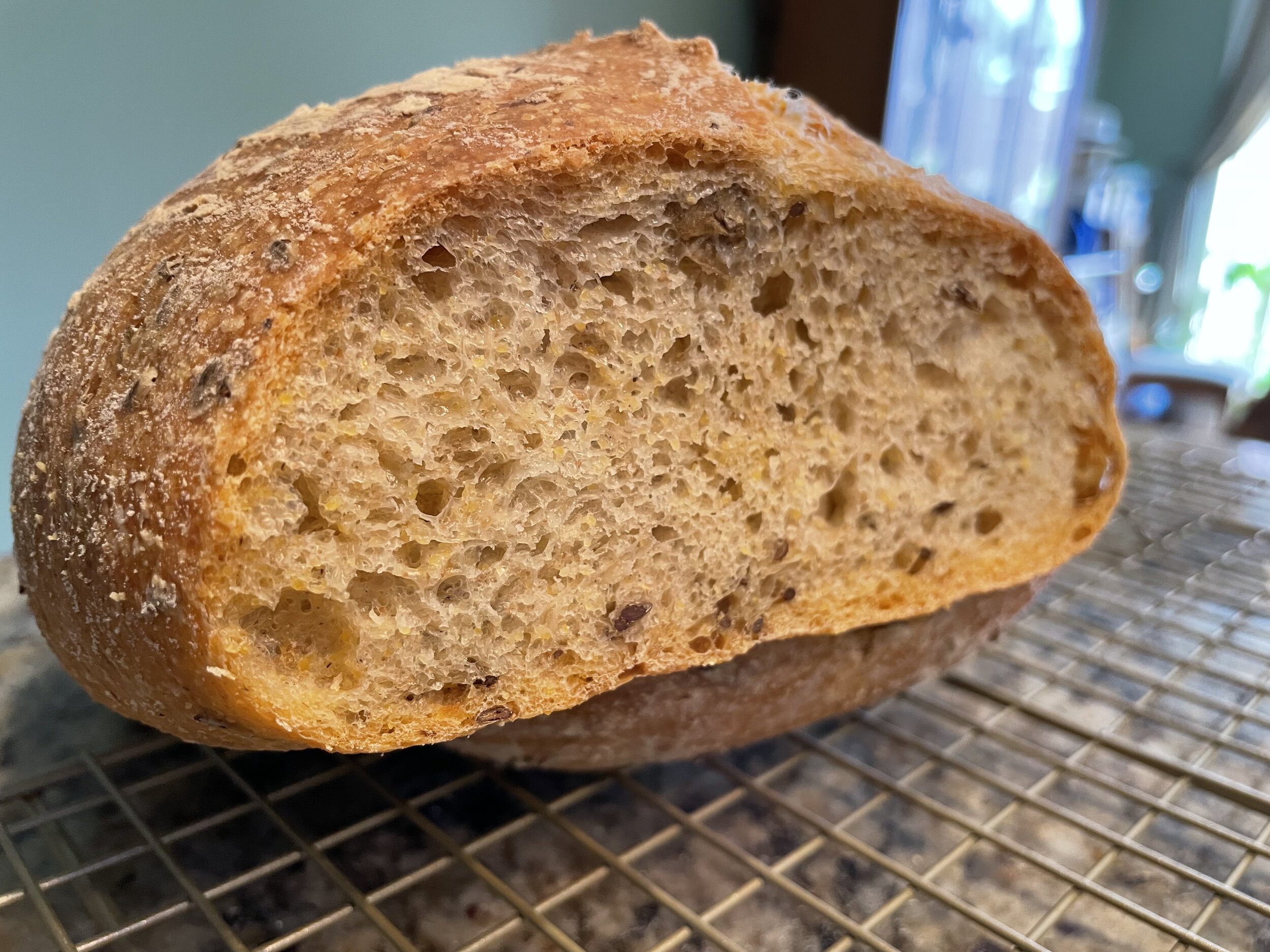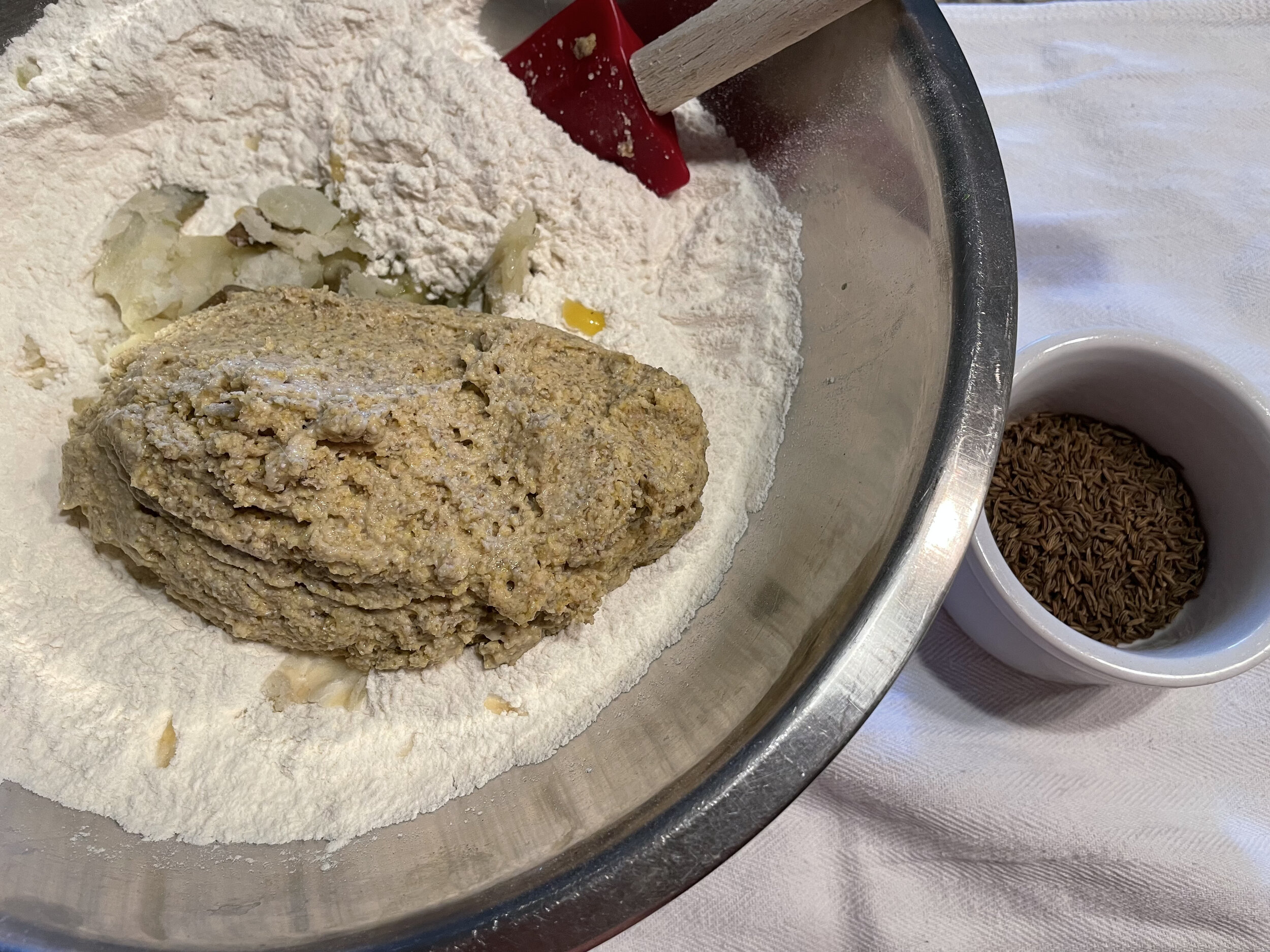Ed Bread, Corn Rye
Dr. Edward D. Frohlich was my father-in-law. He loved this bread and he gave me the formula when I became part of the family. He passed away 2 years ago this week. I want to remember him this week with his favorite bread.
Ed Bread began with a friend of Ed's, Dr. Sol Papper. Many Sundays, Sol would wake the Frohlich family up. Sundays at 7:30am, Dr. Papper would ring the door bell in Oklahoma City,holding either fresh bagels or a magnificent corn rye bread. He worked long and hard to perfect his formulas, which is how Ed Bread came to be. One day, after much coaxing, Sol gave a piece of paper to Ed with the corn rye bread recipe on it. Ed somewhere along the line thought that either he or Sherry would try a stab at making a loaf. That did not happen. It wasn’t until 1991 that he passed it on to me. We made it often and I dubbed it “Ed Bread”. Even though I have made it in many variations over the years, I still cherish that original copy of the recipe.
In the nineties and early 2000’s, Ed and Sherry would come over to have dinner with us quite often during the summer. They only lived a block away. Many of those dinners would start with some bruschetta slathered over Ed Bread. We could polish off a 500g boule before dinner. We usually enjoyed a Scotch with it. He enjoyed our dinners as well. He was very complimentary of my food as well. He would often ask what I did to make the steaks so good. He questioned whether I had a special seasoning. I told him, I just seasoned with salt....and love.
Let's raise a glass and some Ed Bread to him this weekend. I miss him very much.
On a technical tip, the bread is pretty interesting as you have several flours at play. You have just a little sugar and fat. And then there’s the potato. What happens is that you have three sources of starch in this bread; the cornmeal, potato and the rye/bread flours. This could make the bread very crumbly. But it’s not. It does make sense to use a high quality bread flour though.
One more thing, Ed became very salt sensitive later in his life. He had devoted a good part of his research to how salt affects the human body and the heart specifically. I wouldn’t say he was anti-salt. But he was very careful how he used it. He asked me if I could make a version that had less salt. I explained to him that 2% was pretty standard and that if I did lower the salt content, the bread would be bland. We tried it anyway. I also made him some low salt bagels. I could not eat them as they were not to my liking but he loved them. He told me, “This is the perfect amount of salt!”. As always, Ed was definitive in what he liked and didn’t like. I’m just glad I got to make bread for him. Now on to the formula.
Ed Bread
1000g bread flour 80%
150g rye flour 12%
100g cornmeal 8%
475g water 47.5%
25g instant yeast 2%
25g kosher salt 2%
15g gran sugar 1.25%
30g vegetable oil 2.50%
200g cooked potato 16%
30g caraway seeds 2.50%
Notice, I’m using the water I boiled the potatoes in. It adds starch and really changes the texture of the crumb.
Since this formula uses mashed potatoes, you either make it when you have leftovers or you can make them for the formula. But they should be cooled down before you add them to the bread. One fun thing you can do is use the water from boiling your potatoes in the bread. It’s rich with starch from the potatoes. The water should be cooled down as well. One last note about the potatoes is that you can use roasted potatoes but you must increase the water by 10% if you do.
Combine the cornmeal, rye flour, instant yeast and water. We’re making a sponge from those ingredients. One of the advantages of this is that you get some yeast action in the form of co2 gas but you also are hydrating the rye and cornmeal. They tend to be the ingredients that don’t get fully hydrated. Let the sponge ferment for an hour. You will see some action as rye and cornmeal ferment quite well and fast. Then combine all the rest of the ingredients except for the caraway seeds. The caraway seeds are a somewhat American addition to this dough. In Germany, caraway is not used as much in rye breads. They are delicious but can be left out if you don’t like them. When you mix the dough, you can either mix by hand to a rough dough and let it sit for an hour before your first stretch and fold. Or you can mix using a mixer for 4 minutes on slow and 4 minutes on fast. You’ll still need to do a stretch and fold after an hour but it just makes it a bit easier. I tend to mix it by hand.
However you mix, you’ll place it in a container to ferment overnight. It can be made in one day but you do need some time for hydration and some time for fermentation. It’s just easier to mix one day and bake the next. Remember you will pick up some beneficial flavorful bacteria overnight. When you open the container after fermentation, you’ll smell alcohol, like beer. And the dough will be somewhat sweeter. That is the effect of the fermentation on the bread.
After fermentation, divide the dough in 4-500g pieces. Round them roughly and let them come to room temperature covered on the bench. Give them about 25 minutes. Then come back and shape them into boules or round loaves. If you like batards, football shapes, this bread lends itself nicely to that as well. Place the shaped loaves on parchment paper or bannetons for proofing.
Let the loaves rise until doubled in volume. This may take up to 2 or 3 hours. Don’t rush this step. It will determine the texture and doneness of your bread. If you underproof, you will have a gummy interior to the bread and the crust will be very dark. It will be dense and unappealing. Give the bread plenty of time to rise and you’ll have an open crumb and a bread that will be perfect for making sandwiches.
Once the bread has reached double in volume, you’re ready to bake. Preheat the oven to 450°F. I have been using a Dutch oven to bake my loaves recently and it really has improved the crust quite a bit. Preheat the cast iron Dutch oven before baking the bread if you are using it. I put the bread on a piece of parchment and use it as a sling to drop the bread into the Dutch oven. I would suggest putting a towel on the countertop and placing the hot Dutch oven on it. It’s much easier to load the bread away from the oven. Bake 20 minutes with the lid on to steam the bread. And then take the lid off and bake another 12 minutes. If you are not using the Dutch oven, the bread should be done in 25-30 minutes. It should be a golden brown when it’s done. The more color you can get on the crust, the better. Take the bread out and place it on a wire rack to cool.
It sure was great to have this bread again. It really brought back some memories of Ed. We had a bit of a remembrance of Ed on Zoom recently with family members. I enjoyed some whiskey and some Ed bread to remember him by.
Ed was a funny man. I loved his humor. I remember going shopping with Margie, Sherry and him to say, Talbots. He would say, sit down here and point to the chairs they have for men who wait. He would regale me with stories of when he was in the Army or when he treated Miles Davis at the VA hospital in Chicago. He loved to pass on his wisdom. And he had a lot of it.
He would say, “Let the hotels work for you!” If you needed a place to rest in a big city, he would always direct us to go to the best hotels, the Four Seasons, The Ritz, The Plaza to rest. I use that advice to this day!
But it was at home that Ed felt the best. He would say, sit down next to me and let’s talk. He loved to talk about everything. He especially enjoyed history and we would explore avenues of history in every time and subject.
He loved and recognized my love for food. When we would visit New Orleans or he and Sherry would come to Chicago, they would take us to the best restaurants; Commanders, Antoines, August, Mr. Eds. Truly, he showed me what fine dining could be. He also sat at our table many times and I was proud to be able to show off my culinary skills. He loved my steaks and breads.
I do remember one very funny incident. I don’t remember where we were going but the whole family was crammed in a very small Honda Civic. I was driving and he was in the passenger seat next to me. He leaned over before we got going and said, “you know Tom this car is like a Ramada Inn.” I asked him how that was. He said, “no ballroom!” We laughed uproariously to the confusion of the rest of the car. We had a lot of moments like that. I will miss those very much. Enjoy the bread, Ed! Happy baking.
Chef Tom








